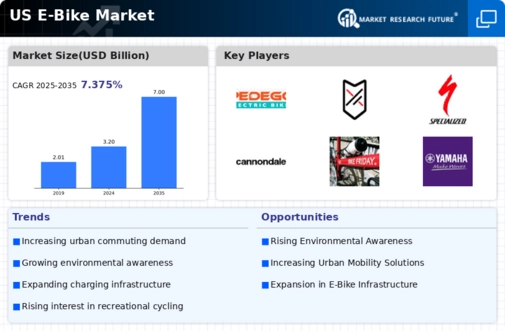Urban Mobility Solutions
The e bike market is experiencing a surge in demand as urban areas seek efficient mobility solutions. With increasing traffic congestion in cities, e bikes offer a practical alternative to traditional transportation methods. According to recent data, urban areas have seen a 30% increase in e bike usage over the past year. This trend is driven by the need for quick, eco-friendly commuting options that reduce reliance on cars. As cities invest in cycling infrastructure, the e bike market is likely to benefit from enhanced accessibility and safety for riders. Furthermore, government initiatives promoting cycling as a sustainable mode of transport are expected to bolster the e bike market, making it a key player in urban mobility strategies.
Health and Fitness Awareness
The growing emphasis on health and fitness is significantly impacting the e bike market. As more individuals prioritize physical activity, e bikes are perceived as a means to combine exercise with transportation. Recent surveys indicate that 45% of e bike users cite health benefits as a primary motivation for their purchase. This trend suggests that the e bike market is not only appealing to commuters but also to fitness enthusiasts looking for enjoyable ways to stay active. The ability to adjust pedal assistance allows riders to customize their workout intensity, making e bikes an attractive option for a diverse demographic. Consequently, the e bike market is likely to expand as health-conscious consumers increasingly recognize the benefits of integrating cycling into their daily routines.
Technological Advancements in E Bikes
The e bike market is witnessing rapid technological advancements that enhance user experience and performance. Innovations such as improved battery life, lightweight materials, and smart connectivity features are attracting a broader audience. Recent developments indicate that e bikes now offer battery ranges exceeding 100 km on a single charge, addressing one of the primary concerns of potential users. Furthermore, the integration of GPS and smartphone applications allows riders to track their routes and performance metrics, making e bikes more appealing to tech-savvy consumers. As manufacturers continue to invest in research and development, the e bike market is likely to see increased competition and a wider array of options, catering to diverse consumer preferences.
Rising Fuel Prices and Economic Factors
The e bike market is being influenced by rising fuel prices and economic considerations. As gasoline prices fluctuate, consumers are increasingly seeking cost-effective alternatives for transportation. E bikes present a compelling solution, with operating costs significantly lower than those of traditional vehicles. Data suggests that e bike users can save up to $1,000 annually on fuel and maintenance expenses. This economic advantage is likely to drive more consumers towards the e bike market, particularly in urban areas where commuting costs are a concern. Additionally, as economic conditions evolve, the affordability of e bikes, coupled with financing options, may further stimulate market growth, making them an attractive choice for budget-conscious consumers.
Environmental Regulations and Incentives
The e bike market is being shaped by stringent environmental regulations aimed at reducing carbon emissions. As cities and states implement policies to promote cleaner transportation options, e bikes are emerging as a viable solution. For instance, various states offer tax incentives for e bike purchases, which can reduce costs by up to 15%. This financial encouragement is likely to drive consumer interest and adoption. Additionally, the e bike market benefits from growing public awareness of climate change and the need for sustainable practices. As more consumers seek eco-friendly alternatives, the e bike market is positioned to thrive, aligning with broader environmental goals and regulations that favor low-emission transportation.






















Leave a Comment